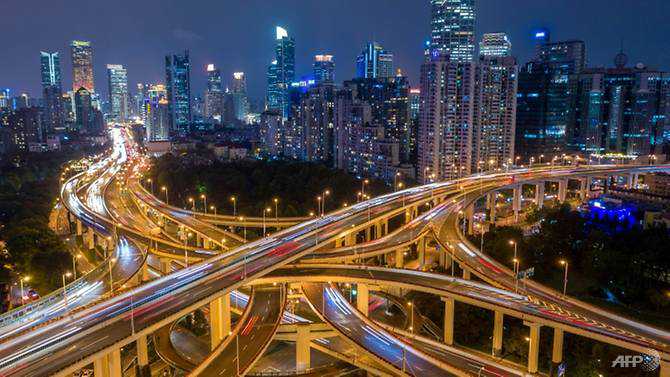Commentary: China’s economy is certainly slowing but growth is still robust
29 January, 2019

China’s economy had an unexpected downturn in 2018. Industrial upgrading, economic policy battles and trade friction with the United States all contributed to the slowdown. The government is implementing policy measures aimed at stabilising economic momentum, but downward pressure on the economy will likely continue in 2019.
If the government is able to fine-tune its economic policies and adopt counter-cyclical measures, China can still achieve a robust pace of economic growth this year — as long as trade friction risks remain under control.
The so-called "middle-income trap challenge" led to a slowdown in China’s growth after 2010. GDP per capita rose from US$3,600 in 2007 to almost US$10,000 in 2018.
Having lost the low-cost advantage, China must build new industries through innovation and industrial upgrading to support the next phase of its economic development. Moderation of growth will likely continue until this battle between old and new industries ends.
CLEANING UP THE ENVIRONMENT SLOWED GROWTH
The sudden weakening of growth momentum in 2018 is mainly attributable to two new developments. One is the government’s three economic policy battles — cleaning up the environment, controlling systemic financial risks and alleviating poverty — launched in early 2018.
All are necessary to improve the quality of economic growth. But the first two slowed growth down directly.
To clean up the environment the government abruptly shut down many high pollution production facilities, especially in northern China. To reduce financial risks, regulatory authorities took measures to control shadow banking transactions. This led to a reduction of total social financing and economic activities cooled quickly.
Unexpectedly, these policies hit the private sector hard. Although policymakers did not specifically target private enterprises, they typically have lower environmental standards and receive more funding through shadow banking. This created disproportionate difficulties for the private sector, prompting nation-wide debate about its position in the Chinese economy.
The government responded by reversing policy towards the private sector and reiterating its importance in the Chinese economy. Some officials also spoke about "competitive neutrality", but it remains uncertain how this can be implemented effectively.
READ: Where did all the Chinese consumers go to? A commentary
TRADE WAR AFFECTING INVESTOR CONFIDENCE
The trade friction with the United States is as yet having limited direct impact on China’s trade activities. But it is affecting investor confidence and probably delaying planned business investment.
Whether the trade war’s full effect — estimated at 0.5 to 1.5 per cent of GDP — will materialise depends on how long it drags on and how serious it becomes.
The economy weakened visibly during the fourth quarter of 2018. But the Keqiang Index (a composite measure of freight, credit and power consumption) still indicated decent economic growth — albeit slower though not significantly than that officially reported.
More importantly, while the manufacturing purchasing managers’ index (PMI) dropped below 50 in December 2018, the non-manufacturing PMI confirmed robust expansion. This is consistent with the general theme of a battle between old and new industries.
With the government now fine-tuning its environmental and financial policies, their drag on economic momentum is likely already easing. It is also expected that China and the United States will reach some partial agreement on trade friction during the second quarter of 2019 at latest, although a full resolution is unlikely in the near future.
The two governments are probably making deals on balancing bilateral trade imbalances, opening up China’s services sector and improving protection of intellectual property rights.
ROOM FOR POLICY REFORMS
After the global financial crisis, Chinese policymakers formed a consensus that China should not rely on aggressive fiscal or monetary policy expansion as it did in 2009. But when the economy suffers a downturn the government should still take some counter-cyclical measures, albeit of a more modest magnitude.
Today the Chinese government has limited room to take counter-cyclical policies. Expected policy hikes by the US Federal Reserve Bank in 2019 constrain the People’s Bank of China’s ability to adopt monetary policy easing given limited exchange rate flexibility.
Large liabilities by local governments and affiliated local government investment vehicles limit scope for further fiscal policy expansion. And high leverage ratios cap credit and financing growth.
The government must enhance its policy space. To strengthen monetary policy independence, the People’s Bank of China should consider either increasing exchange rate flexibility or tightening management of cross-border capital flows.
Some policymakers are worried this could increase fiscal risks if the fiscal deficit exceeds 3 per cent of GDP. But in reality, consolidated government debts are still about 50 per cent of GDP — a 3 per cent fiscal deficit should not become a hard constraint for the government.
High leverage ratios are now perceived as the most serious financial risk in China. But as most borrowing is done by state-owned enterprises and local government investment vehicles, both of which are associated with the government, it is unlikely China will experience a so-called Minsky moment.
The most effective way of deleveraging would be to shut down zombie firms, but this is not easy given social and economic constraints.
The Chinese government could consider setting up a special vehicle to take over some of the borrowing to cut off inefficient financial flows and take more time to deal with stocks. This would create room for both financial institutions and the corporate sector to re-leverage and grow.
More than 20 years ago when Chinese banks had around 40 per cent bad loan ratios, the government established four asset management companies, which purchased about 1.4 trillion yuan (US$206 billion) worth of bad loans from the banks at face value. This relieved the banks of their debt burden and enabled the start of a new round of restructuring.
There’s a case for contemplating a return to these measures to ease the burden of the structural adjustment that China has to undertake now.
